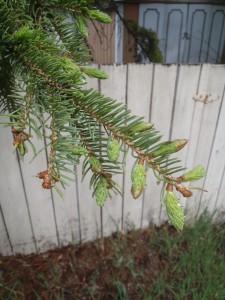 Last year I wrote briefly about evergreen syrup, flavoured with the flourescent, tender bundles of needles that appear on spruce trees in spring. I first came across this preparation in Austria, where the restaurant I was working at used the syrup to flavour a sauce accompanying the roasted leg of a May deer, a fantastic, fantastic example of terroir-driven flavour pairing. The syrup also has obvious applications in the pastry kitchen.
Last year I wrote briefly about evergreen syrup, flavoured with the flourescent, tender bundles of needles that appear on spruce trees in spring. I first came across this preparation in Austria, where the restaurant I was working at used the syrup to flavour a sauce accompanying the roasted leg of a May deer, a fantastic, fantastic example of terroir-driven flavour pairing. The syrup also has obvious applications in the pastry kitchen.
This week I made the syrup myself for the first time, and I want to relate a few of the details of its preparation.
I’m kicking myself for not getting an exact recipe from Looshaus. I recall that they brought the syrup and evergreen tips to a simmer, then removed the pot from the stove immediately. However, a quick internet search of the syrup’s true German name Maiwipferlhönig yielded many suggestions to boil the tips vigorously for half an hour. This method sounded promising. I know that in beer-making extracting the flavour from hops flowers requires extensive boiling. There are a lot of similar flavours between hops and evergreen needles, so perhaps the long boiling method would yeild a more flavourful syrup?
I tried the two methods side by side. Both pots contained:
- 2 oz spruce tips
- 5 oz granulated sugar
- 10 oz cold water
The first pot was brought to a boil, then poured into a jar and left to stand at room temperature overnight.
The second was boiled vigorously for 30 minutes. Every 10 minutes I added a bit of water to maintain the liquid level. After boiling this mixture too was jarred and left on the counter overnight.
Jar One: Quick Simmer
- appearance: liquid is clear and without sediment; a faint, dull, brown-green tint
- aroma: medium to strong smell of spruce; clean and minty
- taste: tastes like it smells – strong, minty evergreen
Jar Two: Long Boil
- appearance: liquid is cloudy with a faint, dull, brown-green tint
- aroma: unmistakably evergreen, though slightly muted compared to jar one
- taste: a mild evergreen taste; resinous, slightly bitter; also gives a slight impression of acidity
In hindsight these results make perfect sense. Now that I reconsider the hops analogy, I believe that the extensive boiling in beer-making is done to extract the bitter flavours of the hops. Lengthy boiling destroys the finer aromas of the hops, so hops that are meant to contribute to the scent of the beer are typically added at the very end.
All in all I vastly prefer the character of the quick simmer method. I’m also reasonably happy with the strength of the aroma and flavour produced by this ratio of spruce tips to syrup, though I’ll be trying some stronger batches in the near future.
